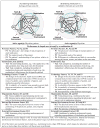SEIPS 2.0: a human factors framework for studying and improving the work of healthcare professionals and patients
- PMID: 24088063
- PMCID: PMC3835697
- DOI: 10.1080/00140139.2013.838643
SEIPS 2.0: a human factors framework for studying and improving the work of healthcare professionals and patients
Abstract
Healthcare practitioners, patient safety leaders, educators and researchers increasingly recognise the value of human factors/ergonomics and make use of the discipline's person-centred models of sociotechnical systems. This paper first reviews one of the most widely used healthcare human factors systems models, the Systems Engineering Initiative for Patient Safety (SEIPS) model, and then introduces an extended model, 'SEIPS 2.0'. SEIPS 2.0 incorporates three novel concepts into the original model: configuration, engagement and adaptation. The concept of configuration highlights the dynamic, hierarchical and interactive properties of sociotechnical systems, making it possible to depict how health-related performance is shaped at 'a moment in time'. Engagement conveys that various individuals and teams can perform health-related activities separately and collaboratively. Engaged individuals often include patients, family caregivers and other non-professionals. Adaptation is introduced as a feedback mechanism that explains how dynamic systems evolve in planned and unplanned ways. Key implications and future directions for human factors research in healthcare are discussed.
Figures
References
-
- Altman Klein H, Lippa KD. Type 2 diabetes self-management: Controlling a dynamic system. Journal of Cognitive Engineering and Decision Making. 2008;2:48–62.
-
- Altman Klein H, Meininger AR. Self management of medication and diabetes: Cognitive control. IEEE Transactions on Systems, Man and Cybernetics. 2004;34:718–725.
-
- Alvarado CJ. The physical environment in health care. In: Carayon P, editor. Handbook of Human Factors and Ergonomics in Health Care and Patient Safety. 2. Boca Raton, FL: CRC Press; 2012. pp. 215–234.
-
- Ausserhofer D, Schubert M, Desmedt M, Blegen MA, De Geest S, Schwendimann R. The association of patient safety climate and nurse-related organizational factors with selected patient outcomes: a cross-sectional survey. International Journal of Nursing Studies. 2013;50:240–252. - PubMed
Publication types
MeSH terms
Grants and funding
LinkOut - more resources
Full Text Sources
Other Literature Sources
Medical


